How to Garden in the Pacific Northwest
We love to get out in our front and back yards and Garden in the Pacific Northwest. We’re known for our fairly mild but wet climate. Which can be tricky to grow what you want in and also seems to be a trumpet call to slugs. And our decent summers that provide just enough sun for a good crop of tomatoes.
Start with Garden Prep in the Fall
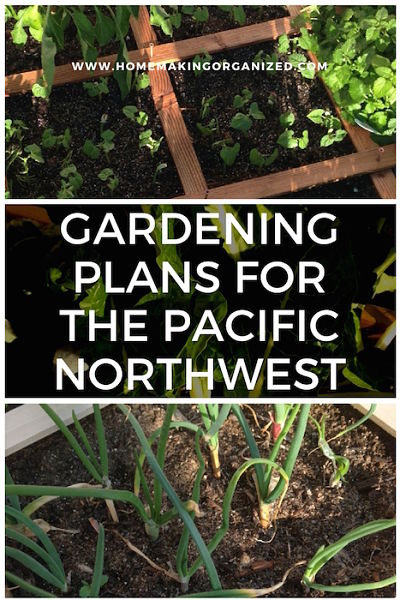
To get your garden off to a good start begin setting things in place in the Fall. The weather is cool and your summer blooms and veggies have died off. It’s time to prepare your beds and borders to be their best when Spring comes.
We do get a good summer which usually truly starts about mid-June (as far as I’m concerned). And August is usually the hottest month for us. Things calm down mid-September and we’re back to rain about the end of October.
Mulch: Put your garden to rest with a few inches of mulch. Use something, like wood chips, that will break down and add nutrients to the soil over the winter. If you do decide to use wood chips put them in beds where nothing is growing or put down a layer of leaves first as the wood chips can deplete the nitrogen in shallow rooted plants.
Compost: Adding good compost to your vegetable beds in fall is a great idea. I know some people wait and add their compost in spring but it really works best when add your compost to your beds in the fall.
If you want some pretty spring flowers like tulips, daffodils, iris, crocus, hyacinth, and Lily of the Valley now is the time to plant them.

MAke Gardening Plans IN Winter
Even though it’s still a little chilly and wet out it’s best to get a good start on the garden by late March. Provided there is no inclement weather like snow. Spring can be dicey and we can get rain and hail well into late April! Then it’s just wet and cold to cool after that until June…ish. Not necessarily fun for gardening but we hang in there.
It is in that warm weather time that we lap up all the gardening and sunshine we can!
Right now (March), in the stores, people are gearing up for the gardening season. There are a few annual flowers out, a smattering of small fruit trees, and bulbs. Not to mention all the soils and amendments to help you have the best season yet. This prep time usually lasts until about May when we finally get some warm days. They might come earlier but putting out summer veggies such as tomatoes before Spring Break (April) can mean problems with the crop. I know this from experience.
We’re pulling out our gardening planners and friends and family are also discussing their gardening plans. In our own home we’re talking about our raised beds, creating some flower borders, and where to plant the strawberries (Which have been traveling with me from apartment to rental home to, finally, their forever home {I hope} for 20 years. In a pot no less! They now get a permanent home! Yay!) I’ve also been handing out runners whenever I can. These things are hardy! You can see a picture of them below. This a small patch I started from a runner. These are growing on a very unfriendly stretch on top of some rocks in the back of our yard. Our strawberries are hardy! I can’t say that enough. I originally bought them from one of those mailers that you probably throw out but I took a chance on. Keep that in mind.
I talk about strawberries more within this article so be sure to read on for how I deal with them.

Planting Zones for the Pacific Northwest
If you live in the Pacific Northwest your Gardening Zone usually falls within Zones 7 through 9. I’m in Zone 8 in Southwest Washington. Actually Zone 8a according to the USDA Hardiness Zone Finder. That number helps when it comes to picking up tips and which plants to grow. Be sure and visit to know what zone you are in.
The spring weather here in the Pacific Northwest is fairly mild but rather wet. It seems that trees and shrubs are all ready for spring but budding too early may be detrimental to their health. Our last frost date is sometime at the end of April. The charts all say this and it’s so true. We can have wild weather until then so be careful what you put out and you might even think of a cold frame to help with sudden hail or heavy winds. But even then you may find yourself waiting until early June to put out things like tomato starts and peppers.
Where I am summer vegetables are usually spent by the end of September. I like to drag that out until October and usually wait until the second to the last week of October to put the garden beds to rest. Our rain is usually full force by then.
In our 8b garden zone we are usually able to grow most vegetables without too much trouble from the weather. The main ones that can give us issues are peppers, and melons. Those super heat loving plants have never done too well for me but I won’t give up.
Fruits and Vegetables I’ve Grown Successfully in the Pacific Northwest
- Blue Berries; Blueberries are at the top of my list. They grow so well and pain free here. I have 3 blueberry plants. All different varieties. We have found that planting them on the northwest side of our back yard serves them best. I have a family member that does the same. I never remember to prune or fertilize my blueberries and yet they still produce for me. The only thing I need to save them from are the birds.
- Strawberries: As I mentioned before I have several strawberry patches in my backyard that come from an original set of runners that I purchased over 25 years ago. My patches are still establishing themselves but do very well against a southern facing back fence. I’m currently toying with covering the plants with these Dollar Tree wire baskets to save them from slugs. (gggrrrr slugs)
- Grapes: I haven’t planted any grapes yet and didn’t know I could until recently. I have several friends of Slavic background who ALL have grapes in their backyards. They have promised to share slips (I think that’s what you call it) with me and show me the way.
- Blackberries: Actually a weed in our area and people pick them out and about. I didn’t want to grow any but my elderly neighbor insisted and gave me two plants that are thorn free. They are in a pot and I watch them like a hawk.
- Swiss Chard: I have grown Swiss Chard very well in pots but currently struggle with doing it right in raised beds. It grows well but seems to be getting more attacked from pests. Stay tuned or leave your tips below.
- Onions: I love onions. They are like soap for me. You can never have too many. I order them each year from Dixondale Farms. I follow their planting directions and have a bumper crop every year.
- Potatoes: I used to grow potatoes in a fabric pots and it works very well like that. Since moving I haven’t picked up any new pots and I’ll be trying some in a discarded storage bin this season. Stay tuned.
- Tomatoes: Tomatoes how I love thee why dost thou plague me so? I have a love hate relationship with tomatoes. I’m still learning and will get back to you on if what I learned has helped. They do well in our weather and I think I’ve learned even more about them. They deserve their own blog post.
- Cucumbers: These grow well but I’m still learning about how to do them best.
- Zucchini: These grow great in our area. Almost too well. I’m learning a bit about how to make them better so I’ll update this when I’ve tried the new tips.
- Peas: I always plant these too late but they do well here.
- Beans: Plant beans after peas. I’ve forgotten why. Something about the soil.
- Kale: Does well in our area.
- Lettuces: Trying something new this year. Stay tuned.
- Garlic: I planted this from grocery store garlic for the first time this past fall. I’ll be harvesting in June or July I think. I’m clueless.
I’m pretty much guaranteed to have a good crop with these every year. My no fails. Things that I don’t do so well. Or at least haven’t done well in the past include…
- Peppers
- Carrots
- Broccoli
- Corn
- Cauliflower
Some Spring tips for Gardening in the Pacific Northwest are…
- Use the spring to clean up your garden beds. Banish weeds and put down mulch for those pretty flowers.
- If you have spring bulbs like tulips and Easter lilies clean up the area around them so they will look their best!
- Weed when the ground is wet and it’s easy to pull the weeds.
- Spring is the time to prune.
- Hire teens to help you with weeding and pruning. Teach them the ropes. Our neighbor is doing this for our daughter and she is brining her new found skills home. Yeehaw!
- Hopefully you didn’t stress too much about your lawn during the fall and winter but now is the time to give it some love. Dethatch and feed.
- Look out for slugs that want to devour your hard work. There are a few ways to deal with these creatures. Some humane. Some not so much. This year we are trying to support our strawberries a little higher so we’ll actually get to taste some. We’re using these strawberry supports from Gardeners.com and these wire baskets from the Dollar Tree. We got to share one strawberry last year and know how sweet they are so it will be nice to get a few more before the slugs have their feast. By the way, we did try hazelnut shells which did not deter them. If you are willing to risk it you can find some here.
About Gardening Vegetables In the Pacific Northwest
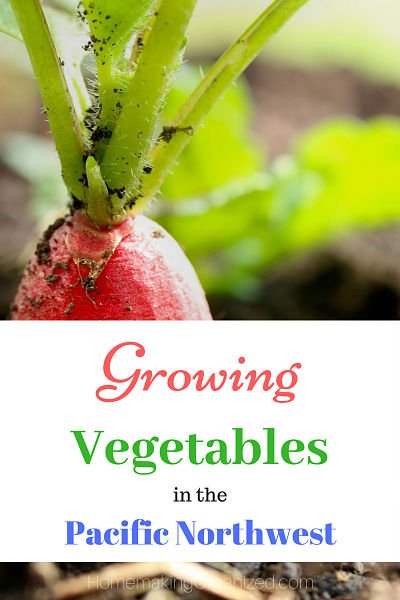
Growing vegetables in the Pacific Northwest is just like growing them in other places.
- You have to account for the kind of weather.
- You have to take into account your growing season.
- And then you have to figure out how to fight the pests particular to your area so you can eat some stuff too (or learn to share).

Start your garden seeds indoors in very early spring

Because of our late outdoor gardening time (late April) sometimes I like to get a head start on my vegetable gardening by sowing seeds indoors. I tend to try different things each year but one thing remains the same and that’s the need for a lot of light!
Not many people that I know who garden start their vegetables from seeds but it’s a great way to save money on what can turn into an expensive hobby if you’re not careful. The main thing I start from seeds are tomatoes. They usually fare better than the ones I buy from the store and I can try all sorts of varieties. I also sometimes start peppers and zucchini from seed.
To grow these items in doors I use the windows I have on the northern and southern sides of my home. It’s a little tricky because we have a cat and so I try and set something up in one of the rooms with good windows.
I’ve used different seed starting setups over the years. I went from using a simple garden bulb to the Jumpstart T5 Grow Light System (Which was actually okay but it was not as sturdy as I wanted and took up more room than I had. I gave it away.) and finally ended up with The Sunblaster Micro Grow Light (that’s it in the image above in a south facing window). And this time I also purchased extra bulbs!
I do have a love hate relationship with starting seeds indoors. The gentle hardening off my plants, sometimes as late as May, can be difficult with high winds and cooler weather (even though threat of frost is gone). I keep my fingers crossed that a stiff wind doesn’t take my poor plant babies out before they’ve had a chance to set down roots.
And that’s how I start the vegetable seeds. I’m not great at it but I keep at it.
Springtime Yard Clean Up for Summer Gardening in the Pacific Northwest
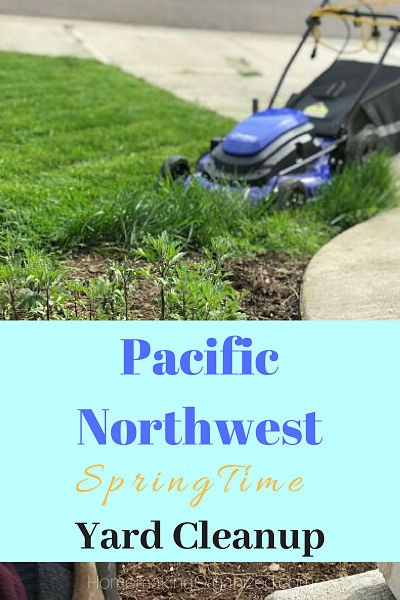
While the seeds are getting a head start indoors and before we start planting anything new outside my husband and I start thinking about cleaning up the yard and garden beds.
Since our winters can be mild some people head outside as early as late January because the call of the yard is so loud.
I like to keep warm and dry as long as possible so it’s only when things look unbearably unkempt that I venture out there.
Removing weeds and cultivating garden beds takes work. In the beginning, I didn’t use the right tools and got really frustrated. A couple of years ago I bought the Garden Weasel Garden Claw and love it! I had spotted my neighbor using it one day and asked her about it. She loaned it to me and I was hooked. My husband poo pooed it afterwards, preferring to go the hard way and use only muscle route. But then he had a big patch of land to cultivated and I loaned it to hi. He was hooked!
In our home garden cleanup also means tackling the lawn and weeding. Both my husband and I take turns mowing the lawn. We try to get to it on Saturdays but if we’ve been really busy sometimes we’ll tackle it mid week. My husband prefers the Kobalt brand at Lowe’s for this job.
I also do the edging of our lawn. My same neighbor gave me a tutorial on how to edge when we bought the Black and Decker Landscape Edger and Trimmer. She saw how I kept messing up and took pity on me (she has since moved but we remain good friends). I had even watched a few youtube videos and no such luck. Now I’m an old pro and have even found I can use the weed whacker for edging.
For more outdoor cleanup we employ the use of a leaf blower (yaaay) and a Sun Joe Pressure washer which makes our porch and driveway look sparkly new). The pressure washer part isn’t really gardening but in our home it all goes hand in hand.
Gardening in Pots

Back in our previous home I used The Garden Patch Grow Boxes for my whole garden. We lived in a townhome and my back porch was 7×5 ft. I used 6 of these post and some fabric grow pots to grow onions, tomatoes, my strawberries, potatoes, lettuce, Swiss chard, and zucchini. Even though the Garden Patch Pots are plastic they served us so well for 8 years and still have plenty of life in them! After moving I gifted to them a friend who is now on her second year using them on her small back porch.
You can see the pots in the background in the little picture above. I have to find another picture of them but from this angle you can see how much stuff I was growing in them. Those are tomatoes in the pots. You only put in two plants per pot as they grow big! The first couple of years I used their organic fertilizer patch that came with them but after a while I just started using Jobe’s Organic Fertilizer which I use all over my garden.
I still use various pots for gardening but mostly for flowers and herbs which like to take over. Pots are a great way to contain things like peppermint or lemon balm which really want to take over your garden.
For those who don’t have a backyard, space for raised beds, or live in a smaller space innovations like the Grow Tower make a lot of sense for growing lots of veggies.
Growing in Garden Beds
Now that we have a slightly bigger back yard we have gone from gardening in pots to gardening in raised beds. And I love them!
You can buy raised beds or make them yourself. My husband, so far, has built me two kinds of beds. The first ones were based on the Square Foot Gardening book. I loved the garden soil mix that was recommended in the book but I didn’t do too well with the square foot part. We used those raised beds for 2 years before I asked for longer regular rectangular beds. Where I once had 3 square foot beds I now have 2 long rectangular beds. I’m on my fifth year with them.
To make our raised beds my husband purchased untreated wood from Lowe’s. We didn’t want anything leeching into our veggies. What do we know? Nothing. But that’s what we did. The first raised beds my husband nailed together. And, well, he’s not a carpenter, an electrician actually so wood is not his forte. For the longer beds I purchased corner attachers like these from Gardeners.com to make it easy. I like easy. The original ones I purchased are no longer in stock but they also came from Gardeners.com.
We lined the bottoms with weed fabric and every year add more compost to the top. (where does all the soil go? Erosion 101 but I really think the veggies are eating the soil).
I like the raised beds. They are easy to work with and keep weeds at bay…sort of.
Pests in the Pacific Northwest Garden
Finally Gardening in the Pacific Northwest is not without its pests. Our mild winters mean things can live through them. Grrr. So they just come right back out with a vengeance as soon as things get slightly warm again.
To keep cats and birds out of our beds I purchase (yes from Gardeners.com) these stakes and the fencing. They are not 100% wonderful. The clip on the top is nice but you have to be creative with securing the bottoms. Of course the birds can fly in from the top so I also used bird netting over the top. I’ve caught them ripping apart my tomato plants for leaves for their nests. Not nice birdies!
Each year my biggest issues are slugs and aphids.
For slugs I’ve tried various things and the best thing is to keep the food out of their way. As I mentioned earlier we purchased these little raised platforms to keep strawberries out of their path. Our strawberries are good and I would like some too.
Here in the Northwest we also have tried hazelnut shells in the garden. They grow lots of hazelnuts next-door in Oregon so we decked our yard out one year with those…didn’t work.
And finally for slugs we like Sluggo. It’s iron phosphate that breaks down into fertilizer and is safe around gardens and pets. Win win!
And finally another big irritant in my garden is cute, cuddly, big soft, doe eyed stray cats. They love to walk through our backyard stopping long enough to see the beds as a giant litterbox.
We all know I love cats…
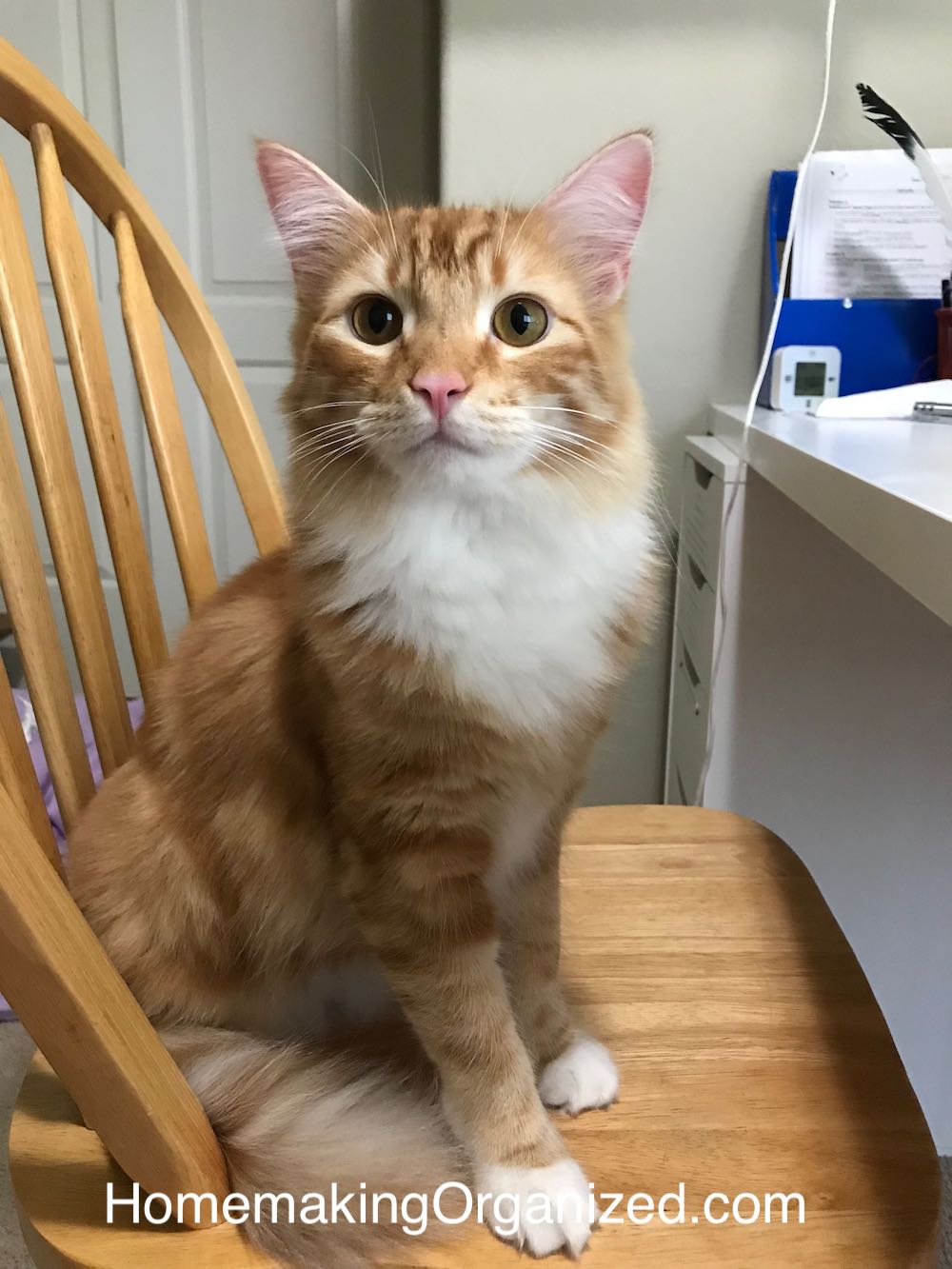
so it’s obvious that I’m not being overly critical.
Anyway I spend a good amount of time figuring out how to keep them away. The fencing I mentioned above does the trick. We just had to make the garden inaccessible to them. Darling creatures.
And finally the birds. They were eating up my blueberries and strawberries. And also ripping apart my tomato plants for leaves for their nests. Good grief! So we bought this bird netting locally and it works well to keep the birds off the berries. It works really well!
Wet Springtime in the Pacific Northwest is the perfect time to Garden
Harvest Time
So that’s how we garden here in the Pacific Northwest.
More Gardening for the Pacific Northwest
- Oops Missed 2018
- Garden update for 2019 (I just updated this post. Why recreate the wheel?)
Don’t live in the Pacific Northwest? Don’t worry….
Gardening Tips for Your Zone
Joybilee Farm in Canada
The Northern Homestead in Canada
Zone 4
Homespun Seasonal Living in Montana
Idlewild Alaska in Alaska
Zone 5
Grow a Good Life in Maine
The Homestead Lady in Utah
Zone 6
Learning and Yearning in Pennsylvania
Little Sprouts Learning in Oklahoma
Pierce Ponderosa in Georgia
Zone 8
Homemaking Organized in Washington (that’s us!)
The Farmer’s Lamp in Louisiana
Preparedness Mama in Texas
Zone 9
SchneiderPeeps in Texas
Linking up with….


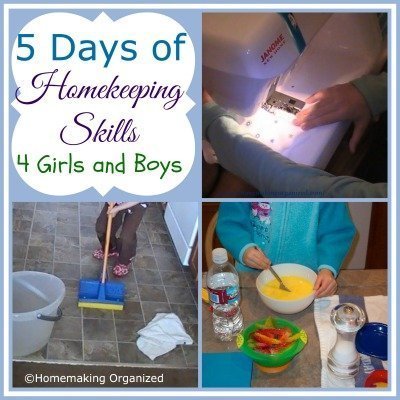

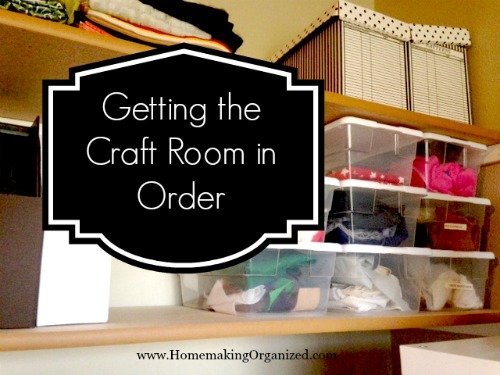

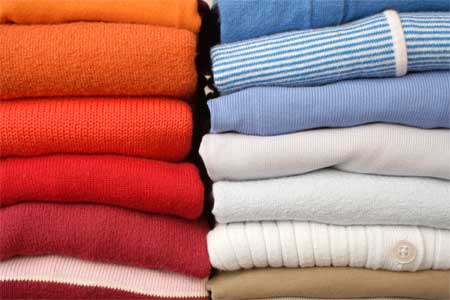
Hello,
So glad I can upon your read. It was so helpful. Any new information for PNW zone 8 is always wonderful reading.
I’ll be trying container gardening this year for the moles love, love (think there’s a den)my raised beds. Which we made from leftover materials that were left at house when moved in.
Thank you for your insight, appreciate:-))
Kemi, I’m mostly interested in your gardening ideas, knowledge, tips, etc. I too live in Zone 8b in Washington and need all the help I can get. Originally from sunny CA I must learn to garden successfully here in the Puget Sound/peninsula area.
Do you have a way for me to glean specifically from your gardening helps?
Hi Lillia! I love MI Gardener for great tips on growing things in our climate. He has a YouTube channel and also a website. The Michigan Zone is similar so a lot of his tips work very well for me. Mostly you have to get used to having a shorter growing season and that some hot weather plants won’t work as well. You can still grow them but might do better with local plants and seeds.
That’s a great collection of garden information – thanks!
You’re welcome 🙂